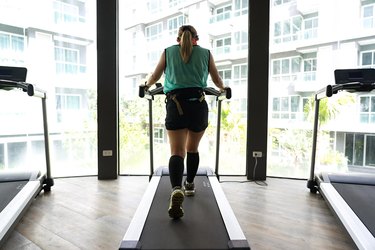
To maintain a general level of good health, the Physical Activity Guidelines for Americans recommends 150 to 300 minutes a week of moderately-intense cardiovascular activity. If you want to drop pounds, you should increase that to between 75 and 150 minutes a week of vigorous cardio activity.
Two fitness machines that you can use to complete these workouts are the stepper-type machine, such as the StairMaster, and the treadmill. A review of their features will help you decide which machine best meets your needs and gives you the best calorie burn for your time.
Video of the Day
Video of the Day
Step on Up
The StairMaster is a stepper machine. Steppers come in two models: the older step climber and the newer step mill. The step climber consists of two footplates that are pulled by an internal chain as you shift your body weight from foot to foot.
The speed at which your legs go into the descending movement is controlled by the "level" on the control panel; going faster and deeper into the steps creates a more intense workout. The movement is supposed to simulate climbing stairs.
The step mill looks like a revolving staircase that you continually climb. You can adjust the rate at which the stairs turn, making your workout more challenging.
Read more: Workout Benefits of the StairMaster
Pick Your Feature
A treadmill provides you with a ramp upon which you can walk, jog or run. The maximum speed of treadmills depends on the grade of the model. In gyms, expect to find treadmills that begin at 0.5 mph. You can increase the speed in 0.1 mph increments all the way up to 12 or 15 mph.
The incline, or ramp, of the belt adjusts in 0.5 percent grades to simulate hills — from 0 percent incline to 15 percent. A few manufacturers produce specialty treadmills that go all the way up to 35 percent and even offer a slight 3 percent downhill grade.
Calorie-Burning Potential
The benefit of any workout depends on how hard you are willing to push. Running at a modest 6 mph pace on the treadmill can burn about 372 calories in a half hour for a 155-pound woman says Harvard Health Publishing.
In addition, you will tone your legs and improve your overall cardiovascular system. Add a hill or increase your speed to increase the calorie burn. Walking or running up hills also develops your backside.
Both stair-stepper machines contribute to cardiovascular endurance and strengthening and toning of your legs and glutes. If you avoid holding onto the handles or console, the StairMaster equipment also improves balance.
In just 30 minutes, a vigorous workout — working at about 65 percent of maximum heart rate — burns approximately 223 calories for a 155-pound woman. You can increase your intensity — going to about 80 percent of heart rate maximum — to bring that burn closer to 400 calories in a half hour.
Advantages and Disadvantages
If you have trouble with balance or knee issues, the stair climber may be a poor choice because it causes some loading on the front part of the knee. Those with joint, especially hip, concerns could find the step mill actually intensifies their problems.
StairMaster machines and treadmills are beginner-friendly, although walking on a treadmill requires less skill than the weight shift of the stair climber or the rhythmic climb of the rotating step mill.
Your body experiences more impact when using the treadmill — especially if you run. If you jump right into an intense workout without building an appropriate level of fitness first, the treadmill may cause shin splints and soreness in the legs.
Build up to running with walk/run intervals at first or hikes on a steep incline. Those who are especially overweight might enjoy the StairMaster machines more because they create less impact on the joints.
Cross-Train With Both
If you are healthy and looking to increase your level of fitness while losing a bit of weight, you should incorporate both stair-stepper and treadmill work into your exercise routine.
Cross-training among different machines reduces the chance of overuse injuries and boredom. It also keeps your body challenged so that you do not fall into an exercise plateau.